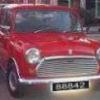http://cgi.ebay.co.u...1742.m153.l1262
It had a yazaki temperature guage, which used to work fine.
I then replaced the sender with a new one (as the old one broke from the bit were the guage wire attaches) and bought another red sender, and the guage didn't work. I am suspecting the sender I bought was defective.
Anyway, I then decided to buy a black temperature sender, like this one
http://cgi.ebay.co.u...1742.m153.l1262
and this time, I replaced the yazaki guage with a smiths guage (as this is the sender/guage combination I have on the other 2 minis I have, and they all read well)...however, the sender gave false readings, i.e when the water was still cold, the temperature used to rise to hot very rapidly.
When I then replaced the black sender with the red sender I had originally, and left the smiths guage, the smiths guage still scaled up to hot, but this time, instead of in a couple of seconds, it took about 15 minutes (or more) and it went up veery slowly. I now suspect that the car is really over heating and the smiths guage with the red sender is a good combination. However, before I get to buy some expensive things like a radiator and a new water pump to adress the overheating issues, I want to make sure the guage is actually reading correctly.
So, my question is, is the sender related to the brand of guage used, or the type of wiring fitted to the car?? That is, is the red sender only associated with the yazaki temperature guage, or can it be used with the smiths guage too? Or was the red sender fitted as standard to the deluxe and cooper s models up to 1969, even with smiths type of guage? Since my mini is an early 1970, it can be the case that they still fitted these same type of senders as they used to in 1969. And since the car is an 850, early mk3 850s had only the centre speedo and no water and oil pressure guages, therefore the sender and guage must have been an aftermarket modification.
by the way, the car had originally a dynamo and it has now been converted to run on an alternator.
thanks everyone in advance
Jeremy
Edited by flamenco, 23 June 2008 - 11:32 AM.















